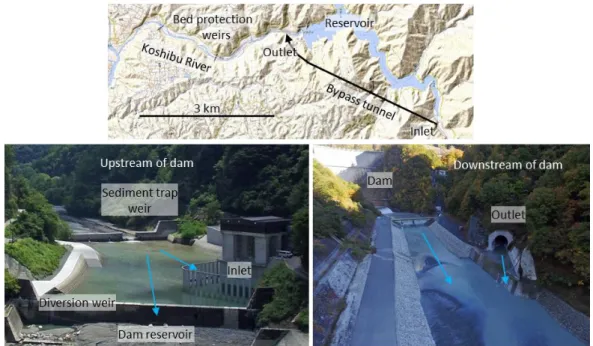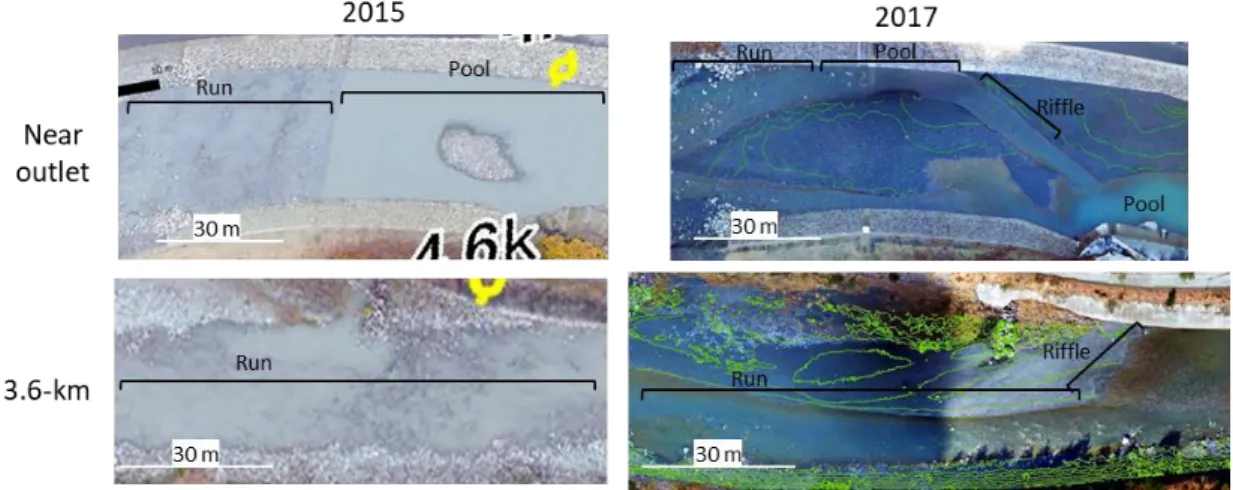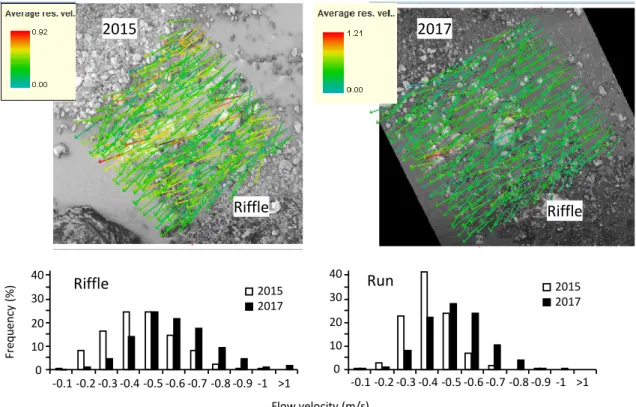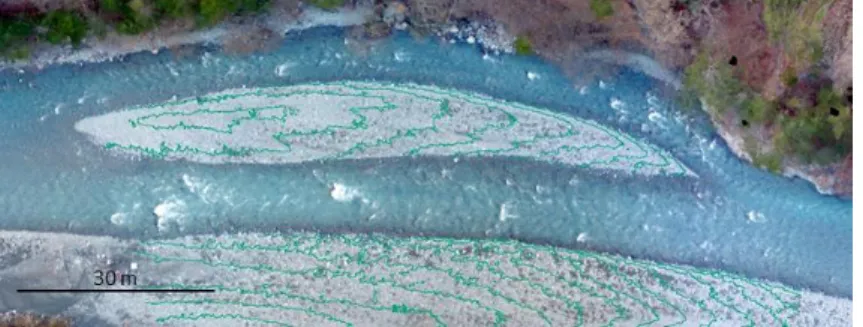Initial changes in riverbed topography after
the operation of sediment bypass tunnel in
the downstream of the Koshibu Dam
Sohei Kobayashi, Katsushi Ishida, Hiroyuki Takeuchi, Tetsuya Sumi, and Yasuhiro Takemon
Abstract
Cross-section profile and bedform were surveyed in the downstream of the Koshibu Dam, where sediment bypass tunnel (SBT) transports finer materials selectively, for the first two years of SBT operation. After the sediment transport by SBT in the second year, about 15,000 m3 sediment was deposited, and gravel bars and riffle beds were generated
within a 1.7-km reach. Our results suggest that supply of sediment through SBT can change bar morphology and pool-riffle structure in the previously degraded channel even without coarse materials (i.e., cobbles and boulders).
Keywords: sand and gravel, downstream, bed change, gravel bar, pool and riffle
1 Introduction
Sediment and flow are essential elements of river ecosystem as they form bars, which are the basis of diverse river habitats for aquatic organisms and ecosystem processes. Channel degradation due to sediment removal or reduced sediment transport by upstream dam is a major environmental issue in many rivers (Fujita et al. 2008). Sediment bypass tunnel (hereafter SBT) as a countermeasure of reservoir sedimentation is an efficient way of supplying large amount of sediment to such degraded channels downstream of dams (Vischer et al. 1997, Boes et al. 2014). Recent studies have demonstrated some positive effects of SBT operation on the downstream riverbed and benthic community (reviewed by Kobayashi et al. 2018). The changes in downstream ecosystem after SBT operation includes an increase of channel slope, decrease of bed grain size, development of gravel bars, increase area of riffles while decrease of pools, increase in similarity between upstream and downstream invertebrate communities, and decrease in turbidity of water. Such changes can occur within a few years after the start of SBT operation.
Some of the new SBTs are planning to transport finer sediment selectively. This is mainly because reservoir sedimentation consists mostly of fine materials such as silt and sand. In addition, coarse materials such as cobbles and boulders are considered to accelerate abrasion damages of tunnel invert and increase maintenance cost. Because previous studies have been done mainly on SBTs that transport both fine and coarse materials, we have limited knowledge on the effect of selective transport of finer materials by SBT. Many ecological studies have suggested adverse effects of increasing fine materials on
river ecosystem such as clogging of bed interstices or covering of bed surface, which can act to reduce abundance and species richness of benthic organisms (Kaller and Hartman 2004). Fine materials are also easily mobilized by floods and are less likely to contribute on the development of bars and pool-riffle structure
The Koshibu Dam, one of the dams with new SBT in Japan, started operation of SBT (test run) and transportation of sediment to downstream since 2016. The target sediment for transport in this SBT is gravel and finer materials. The primary objective of this study was to clarify effects of a selective transport and supply of finer materials on bedforms and habitats in the downstream reach of the Koshibu Dam for the first two years (2016 and 2017).
2 Study site and Methods
2.1 Koshibu Dam, SBT, and downstream
The Koshibu Dam (managed by MLIT: Ministry of Land, Infrastructure, Transport and Tourism) was a flood-control and multipurpose dam built in 1969 in southern mountains in Nagano Prefecture, Japan. The dam height was 105 m, reservoir volume was 58×106
m3, and the area is 288 km2.
SBT of Koshibu was nearly 4.0 km in length and 2.0% in slope, with the inlet at the channel upstream of the reservoir and the outlet a few hundred meters downstream of the dam (Figure 1). The diversion weir that helps to guide flow and sediment into tunnel located at the downstream side of the inlet. Sediment trapping weir in the upstream as well as the diversion weir had roles to trap sediment from upstream especially for coarse materials in order to transport finer materials selectively through the tunnel.
The operation of SBT have been done twice in 2016 and tree times in 2017 mostly during typhoon events from July to October. Total tunnel operation time (2016: 22 hours, 2017: 62 hours), maximum flow discharge through the tunnel (2016: 80 m3/s, 2017: 180 m3/s), and total sediment transport (estimated volume of sand and gravel, 2016: >2000 m3, 2017: >30000 m3) were greater in 2017 than in 2016. More than 50% of inflow sediment was estimated to be transported downstream by SBT in 2017. Deposited sediment near the outlet of SBT was consisted mostly of sand (0.1–2 mm) and gravel (2–75 mm) in both years (d60; 2016: 15 mm, 2017: 25 mm), which suggests that SBT transported sand and
gravel as bedload (see more detail in Koshiba et al. 2019 and Ishida et al. 2019).
The Koshibu River flows almost 5 km from the dam to the confluence of the main stem River, the Tenryu. Two bed protection weirs were located at 1.3 km and 3.0 km upstream from the confluence. The channel was generally around 1/100 in slope, and 30–100 m in width except for the upstream reaches of the two weirs. Bed grain size (d60) was usually
90–200 mm before the start of SBT operation.
2.2 Field survey on gravel bar and pool-riffle structure
Cross-section profile was surveyed periodically each 200-m along the 5-km downstream reach. We used available data of the survey conducted before (2014 or 2015) and after (2016, 2017) the start of SBT in a 1.7-km upper section of the downstream reach, from the outlet (at 4.7-km point) to the 3.0 km bed protection weir. The difference in elevation between the consecutive two years was calculated for each unit width (1 m) excluding high terrace, which are supposed to be unaffected by sediment transport in each section. The difference in elevation was multiplied by 200 m and summed for each cross-section to estimate the volume of erosion and deposition. Aerial photos covering the downstream reach of dam were also available. Based on the orthogonized photo, frequency and area of gravel bars (emerged portion) were estimated.
Riverbed morphology and characteristics of pool-riffle structure were surveyed using drone in three reaches (just below the tunnel outlet, 500-m downstream, 1-km downstream). Photos were taken by a camera mounted on DJI Phantom3 Professional (DJI Science and Technology Co., Ltd.). In each reach the drone flew the whole area 50– 100 m above the ground. Photos with a resolution of 4000×3000 pixels were taken by the camera, which was facing vertically down, with two consecutive photos always overlapping >70%. Agisoft Photoscan Professional Edition (Agisoft LLC, Russia) was used to conduct stereoscope analysis (Structure from Motion and Multi-View Stereo, SfM-MVS) and obtain orthogonized photo and DEM (digital elevation model) data. Videos of flow in pools and riffles were also taken by drone 30 m above the water surface. Spatial distribution of flow velocity was analyzed by a large-scale particle image velocimetry (LSPIV) technique using Fudaa-LSPIV (EDF and Irstea, Jodeau et al. 2018).
3 Results
3.1 Changes in bed elevation
Bed elevation changed less in 2016 (the 1st year of SBT operation) in all cross-sections but near the outlet (at 4.6 km-point), where bed was elevated about 0.8 m due to a sediment deposition in a stilling basin (Figure 2). Estimated change in the volume of sediment between 2014 and 2016 showed net decrease (erosion) in many reaches. In contrast, bed elevation increased in most cross-sections in 2017. The elevation increase was greater in downstream sections (3.2–3.6 km, 0.3–0.5 m) than in upstream cross-sections (4.0–4.4 km, 0.1 m), which is probably associated with wider channel and gentler slope of the former sections (Figure 2). The change in sediment volume between 2016 and 2017 was net increase in all of the reaches.
Total volume of sediment increase in the study reach (3.0–4.7 km) was about 15,000 m3, which was less than half of the bedload transport (sand and gravel) through SBT in 2017. Much sediment seems to be transported further downstream during SBT operation.
Fig. 2: Changes in bed elevation (left) and in-channel sediment volume (right) in 2016 and 2017.
3.2 Changes in bar distribution and area
Gravel bars (emerged area) increased in number after the start of SBT especially in 2017 (Figure 3). A large gravel bar (area ≈ 1300 m2) developed near the outlet in 2016. Small gravel bars (<200 m2) newly developed throughout the reach and one bar increased in area (from 1000 m2 to 1800 m2) in 2017. On the other hand, some gravel bars decreased in area due to increases in flow width and submerged area, as a consequence of decreasing flow depth (see following). Consequently, despite the increase in number of bars, the change in total area of bars was small between 2016 and 2017 (Figure 3).
500 505 510 515 520 -0.2 0 0.2 0.4 0.6 0.8 1 1.2 3 3.2 3.4 3.6 3.8 4 4.2 4.4 4.6 2014 2016 2017 2016 2017 -1 0 1 2 3 4 3.1- 3.3- 3.5- 3.7- 3.9- 4.1- 4.3- 4.5- 4.7-Bed e le vatio n ( m)
Distance from the downstream confluence (km) Bed elevation Difference from 2014
Differ en ce in el eva ti o n fro m 20 14 (m ) 3.0 3.1 3.3 3.5 3.7 3.9 4.1 4.3 4.5 -1 0 1 2 3 4 B ed ch an ge in vo lu me ( 10 3m 3) Deposition Erosion
Reach (distance from the downstream, km) 2014–2016
Fig. 3: Changes in number and area of emerged gravel bars in the study reach.
3.3 Changes in pool-riffle characteristics
The location of pools (areas of deep and slow flow) and riffles (shallow and fast flow, wavy water surface) in the study reach were unchanged in 2016 and 2017 except for the reaches where the bar was newly formed or increased in area. For example, a riffle was newly created at previously run (moderately deep and fast flow) or pool existed area near the outlet (where a new bar developed) and at 3.6-km point (where the bar increased in area) in 2017 (Figure 4). This is due to a difference in water level between upstream and downstream side of the bar and a slope in water surface between them. Decreases of flow width and depth also contributed to decrease flow cross-section area and increase flow velocity to keep discharge.
Fig. 4: Gravel bar and pool-riffle structure at two reaches in 2015 and 2017 (contour: 0.2 m).
In other reaches, although the location of pool and riffle changed less, changes in morphological characteristics of pools and riffles were evident between 2016 and 2017. For example, a riffle became wider and gentler while run and pool became narrower and steeper at 4.0-km point (Figure 5, water surface slope can be inferred from the interval of red points). Due to sediment deposition at mid-flow, riffles became shallower and wider. Due to development of bars that confine the flow as well as sediment deposition at mid-flow, pools became shallower and narrower. In overall, flow was shallow throughout a
0 5 10 15 20 0 2 4 6 8 10 12 2015 2016 2017 N u mbe r o f b ars Su rfac e are a o f b ars (10 3 m 2 )
pool-riffle structure, and clusters of cobbles and boulders that formed step-like bed features previously were less frequent in 2017 than before.
Fig. 5: Gravel bar and pool-riffle structure at 4.0-km (red circles: water edge of 0.2m-interval contours).
According to the change in bedform, spatial pattern of flow velocity also changed. For example at 4.0-km point, flow velocity in riffle and run was greater and spatially much uniform in 2017 than in 2015 (Figure 6). Similarly, flow velocity in pools increased for the whole width in 2017 than in 2015. In overall, due to a disappearance of slow flow areas that previously existed near water edge, pools, and behind boulders, flow velocity became greater and spatially much uniform.
Fig. 6: Analysis of flow velocity by LSPIV for a riffle and run at 4.0-km point. 0 10 20 30 40 -0.1 -0.2 -0.3 -0.4 -0.5 -0.6 -0.7 -0.8 -0.9 -1 >1 2015 2017 0 10 20 30 40 -0.1 -0.2 -0.3 -0.4 -0.5 -0.6 -0.7 -0.8 -0.9 -1 >1 2015 2017 Flow velocity (m/s) Fre q u en cy (% ) 2015 2017 Riffle Riffle Riffle Run
4 Discussion and Conclusion
Sediment deposition and bedform change of the Koshibu Dam were evident throughout the study reach in 2017 when more than 30,000 m3 of bedload sediment was transported
through SBT. Increase of gravel bars and riffles after the operation of SBT, which was shown in this study, has been reported in the previous study of the Asahi Dam SBT. The uniqueness of the Koshibu dam SBT is that it releases finer materials selectively by trapping coarse materials in the weirs near the inlet. Sediment deposit near the outlet suggested that sediment up to the size of gravel was released by SBT. Thus, our results suggest that gravel bars can develop without cobbles and boulders.
However, because sand and gravel are easily flushed by next floods, continuous release of sufficient sediment by SBT every year is probably necessary to maintain these bars. In addition, the dam gates were closed and all of the released flow was via SBT during the events in 2017. If flow was also released from the dam, sediment through SBT may be flushed further downstream and less remained in the studied reaches. Further monitoring is needed to clarify the downstream bedform responses to a given sediment transport through SBT in different dam operations.
The size of gravel bars, which developed in the study reaches in 2017, was flatter (i.e., smaller in height) than those typical in the upstream of dam (compare contours in Figure 4 and 7). Uniqueness of pools (deep and slow flow) and riffles (shallow and fast flow) is more conspicuous when gravel bars are developed in terms of height. Cobbles is assumed to be necessary to maintain a steeper slope and certain height of gravel bars. Thus, although gravel contributed to the changes in bedform in this study, transport of cobbles and even boulders may also be required if we expect a development of gravel bars as in the upstream of dam.
Fig. 7: A typical gravel bar in the upstream of Koshibu Dam.
In conclusion, we investigated the bedform changes in the downstream of the Koshibu Dam for the first two years of SBT operation. The SBT seems to have released sediment to the downstream mainly sand and gravel as bedload. Part of the released sediment was deposited within a 1.7-km downstream reach, and gravel bars and riffle beds were newly generated without cobbles and boulders. Further monitoring is needed to fully understand downstream responses to selective transport of finer materials by SBT.
Acknowledgement
Dr. Christian Auel and Takahiro Koshiba contributed in the progress of our studies of SBT and environment. The study was supported by STB projects of JSPS Kakenhi (26257304) and MLIT Kasen-Sabo-Gijutsu-Kaihatsu.
References
Boes, R.M., Auel, C., Hagmann, M., Albayrak I. (2014). Sediment bypass tunnels to mitigate reservoir sedimentation and restore sediment continuity. Reservoir Sedimentation (A.J. Schleiss, G. De Cesare, M.J. Franca, M. Pfister eds.), Taylor and Francis, London, UK, 221−228.
Fujita, K., Tomita, Y., Oonuma, K., Oro, T., Ito, K., Yamahara, Y. (2008). Facts and introductory knowledge about downstream effects of dams on the physical environment of rivers in Japan: for building a common and scientific basis for discussion on dams and the river environment.
Technical note of National Institute for Land and Infrastructure Management, 445, 52 pp.
Jodeau, M., Hauet, A., Le Coz, J. (2018). Fudaa-LSPIV Version 1.6.4 User Manual. EDF and Irstea, Document Version 03/10/2018.
Kaller, M.D., Hartman, K.J. (2004). Evidence of a threshold level of fine sediment accumulation for altering benthic macroinvertebrate communities. Hydrobiologia, 518(1-3), 95-104.
Kobayashi, S., Fukuroi, H., Sumi, T., Takemon, Y. (2018). Sediment derivation of bypass tunnel restores downstream environment. Twenty-Sixth International Congress on Large Dams, 4th - 6th July 2018, Vienna, Austria, Q.100 -R.28, 454-473
Koshiba et al 2019 in this proceeding Ishida et al. 2019 in this proceeding
Vischer, D.L., Hager, W.H., Casanova, C., Joos, B., Lier, P., Martini, O. (1997). Bypass tunnels to prevent reservoir sedimentation. Q74-R37, Proceeding of 19th ICOLD Congress, Florence, Italy, 605-624.
Authors
Sohei Kobayashi (corresponding Author) Tetsuya Sumi
Yasuhiro Takemon
Disaster Prevention Research Institute, Kyoto University, Japan Katsushi Ishida
Hiroyuki Takeuchi
Tenryu River Office, Ministry of Land, Infrastructure, Transportation, Tourism (MLIT), Japan




